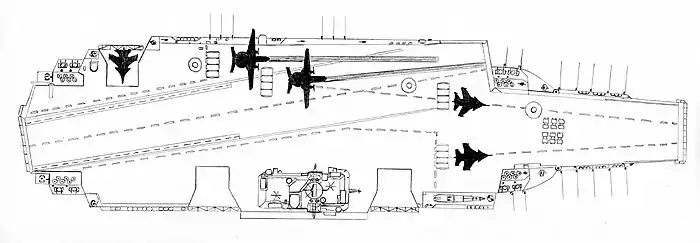Soviet aircraft carrier Ulyanovsk
Ulyanovsk (Russian: Улья́новск, IPA: [ʊˈlʲjanəfsk]), Soviet designation Project 1143.7, was a fixed-wing aircraft carrier laid down on 25 November 1988 as the first of a class of Soviet nuclear-powered supercarriers. It was intended for the first time to offer true blue water naval aviation capability for the Soviet Navy. The ship would have been equipped with steam catapults that could launch fully loaded aircraft, representing a major advance over the Kuznetsov class, which could only launch high-powered aircraft from their ski-jumps. However, construction of Ulyanovsk was stopped at about 40% after the dissolution of the Soviet Union in 1991.
 US Department of Defense artwork of a Soviet nuclear-powered aircraft carrier similar to Ulyanovsk, under construction. | |
| Class overview | |
|---|---|
| Name: | Ulyanovsk class |
| Builders: | Chernomorsky Shipyard 444 |
| Operators: |
|
| Preceded by: | Kuznetsov class |
| Succeeded by: | Project 23000E |
| Planned: | 2 |
| Cancelled: | 2 |
| History | |
| Name: | Ulyanovsk (Russian: Улья́новск) |
| Ordered: | 11 June 1986 |
| Laid down: | 25 November 1988 |
| Launched: | 1995 (planned) |
| Stricken: | 1 November 1991 |
| Fate: | Scrapped at 40% completion |
| General characteristics | |
| Type: | Aircraft carrier |
| Displacement: |
|
| Length: | 321.2 m (1,054 ft) overall[1] |
| Beam: | |
| Draught: | 10.6 m (35 ft)[1] |
| Propulsion: |
|
| Speed: | 30 knots (56 km/h) |
| Range: | Unlimited distance; 20–25 years |
| Endurance: | Limited only by supplies |
| Complement: | 3,400 total[1] |
| Armament: |
|
| Aircraft carried: |
|
Design
Ulyanovsk was based upon the 1975 Project 1153 Orel, which did not get beyond blueprints. The initial commissioned name was to be Kremlin, but was later given the name Ulyanovsk[2] after the Soviet town of Ulyanovsk, which was originally named Simbirsk but later renamed after Vladimir Lenin's original name because he was born there.
It would have been 85,000 tonnes in displacement (larger than the older Forrestal-class carriers but smaller than contemporary Nimitz class of the U.S. Navy). Ulyanovsk would have been able to launch the full range of fixed-wing carrier aircraft, as it was equipped with two catapults as well as a ski jump. The configuration would have been very similar to U.S. Navy carriers though with the typical Soviet practice of adding anti-ship missile (ASM) and surface-to-air missile (SAM) launchers. Its hull was laid down in 1988, but construction was cancelled at 40% complete in January 1991 and a planned second unit was never laid down.[1] Scrapping began on 4 February 1992 and was completed by the end of October 1992.
Air group
The Ulyanovsk air group was to include 68 aircraft with the following planned composition:[1]
- 44 fighter aircraft, combination of Sukhoi Su-33 (Su-27K) and Mikoyan MiG-29K fighters
- 6 Yakovlev Yak-44 RLD Airborne early warning aircraft
- 16 Kamov Ka-27 Anti-submarine warfare helicopters
- 2 Ka-27PS Air-sea rescue helicopters
The ship was equipped with two "Mayak" steam catapults made by the Proletarian factory, a ski-jump, and 4 arresting gear. For storing aircraft, it had a 175×32×7.9-m hangar deck with aircraft elevated to the flight deck by 3 elevators with carrying capacities of 50 tons (two on the starboard side and one on the port). The stern housed the "Luna" optical landing guidance system.

References
- Citations
- Yu.V. Apalkov, "Korabli VMF SSSR", Galeya Print, Sankt-Peterburg 2003
- Rochlin, G. I.; La Porte, T. R.; Roberts, K. H. (Autumn 1987). "The Self-Designing High-Reliability Organization: Aircraft Carrier Flight Operations at Sea". Naval War College Review. LI (3). Archived from the original on December 13, 2006.
- Bibliography
- Saunders (editor), Stephen (2006). Jane's Fighting Ships 2006-7. Coulsdon, Surrey: Janes Information Group. ISBN 978-0-7106-2753-7.CS1 maint: extra text: authors list (link)
External links
- Hazegray.org entry.
- Project 1143.7 Orel Ul'yanovsk class, GlobalSecurity.org.
- A Brief Look at Russian Aircraft Carrier Development, Robin J. Lee.